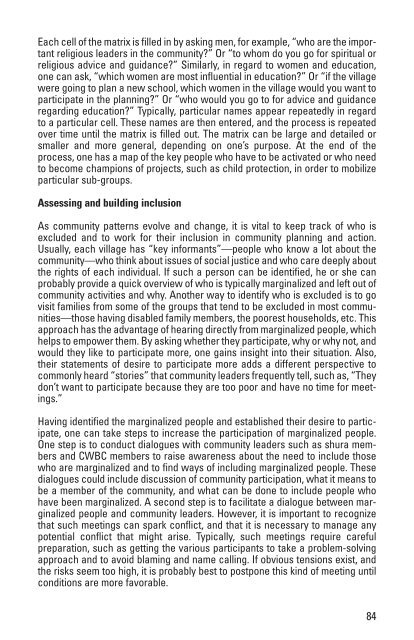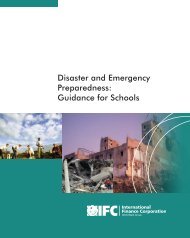Starting Up Child Centered Spaces in Emergencies: A Field Manual
Starting Up Child Centered Spaces in Emergencies: A Field Manual
Starting Up Child Centered Spaces in Emergencies: A Field Manual
- No tags were found...
Create successful ePaper yourself
Turn your PDF publications into a flip-book with our unique Google optimized e-Paper software.
Each cell of the matrix is filled <strong>in</strong> by ask<strong>in</strong>g men, for example, “who are the importantreligious leaders <strong>in</strong> the community?” Or “to whom do you go for spiritual orreligious advice and guidance?” Similarly, <strong>in</strong> regard to women and education,one can ask, “which women are most <strong>in</strong>fluential <strong>in</strong> education?” Or “if the villagewere go<strong>in</strong>g to plan a new school, which women <strong>in</strong> the village would you want toparticipate <strong>in</strong> the plann<strong>in</strong>g?” Or “who would you go to for advice and guidanceregard<strong>in</strong>g education?” Typically, particular names appear repeatedly <strong>in</strong> regardto a particular cell. These names are then entered, and the process is repeatedover time until the matrix is filled out. The matrix can be large and detailed orsmaller and more general, depend<strong>in</strong>g on one’s purpose. At the end of theprocess, one has a map of the key people who have to be activated or who needto become champions of projects, such as child protection, <strong>in</strong> order to mobilizeparticular sub-groups.Assess<strong>in</strong>g and build<strong>in</strong>g <strong>in</strong>clusionAs community patterns evolve and change, it is vital to keep track of who isexcluded and to work for their <strong>in</strong>clusion <strong>in</strong> community plann<strong>in</strong>g and action.Usually, each village has “key <strong>in</strong>formants”—people who know a lot about thecommunity—who th<strong>in</strong>k about issues of social justice and who care deeply aboutthe rights of each <strong>in</strong>dividual. If such a person can be identified, he or she canprobably provide a quick overview of who is typically marg<strong>in</strong>alized and left out ofcommunity activities and why. Another way to identify who is excluded is to govisit families from some of the groups that tend to be excluded <strong>in</strong> most communities—thosehav<strong>in</strong>g disabled family members, the poorest households, etc. Thisapproach has the advantage of hear<strong>in</strong>g directly from marg<strong>in</strong>alized people, whichhelps to empower them. By ask<strong>in</strong>g whether they participate, why or why not, andwould they like to participate more, one ga<strong>in</strong>s <strong>in</strong>sight <strong>in</strong>to their situation. Also,their statements of desire to participate more adds a different perspective tocommonly heard “stories” that community leaders frequently tell, such as, “Theydon’t want to participate because they are too poor and have no time for meet<strong>in</strong>gs.”Hav<strong>in</strong>g identified the marg<strong>in</strong>alized people and established their desire to participate,one can take steps to <strong>in</strong>crease the participation of marg<strong>in</strong>alized people.One step is to conduct dialogues with community leaders such as shura membersand CWBC members to raise awareness about the need to <strong>in</strong>clude thosewho are marg<strong>in</strong>alized and to f<strong>in</strong>d ways of <strong>in</strong>clud<strong>in</strong>g marg<strong>in</strong>alized people. Thesedialogues could <strong>in</strong>clude discussion of community participation, what it means tobe a member of the community, and what can be done to <strong>in</strong>clude people whohave been marg<strong>in</strong>alized. A second step is to facilitate a dialogue between marg<strong>in</strong>alizedpeople and community leaders. However, it is important to recognizethat such meet<strong>in</strong>gs can spark conflict, and that it is necessary to manage anypotential conflict that might arise. Typically, such meet<strong>in</strong>gs require carefulpreparation, such as gett<strong>in</strong>g the various participants to take a problem-solv<strong>in</strong>gapproach and to avoid blam<strong>in</strong>g and name call<strong>in</strong>g. If obvious tensions exist, andthe risks seem too high, it is probably best to postpone this k<strong>in</strong>d of meet<strong>in</strong>g untilconditions are more favorable.84
















